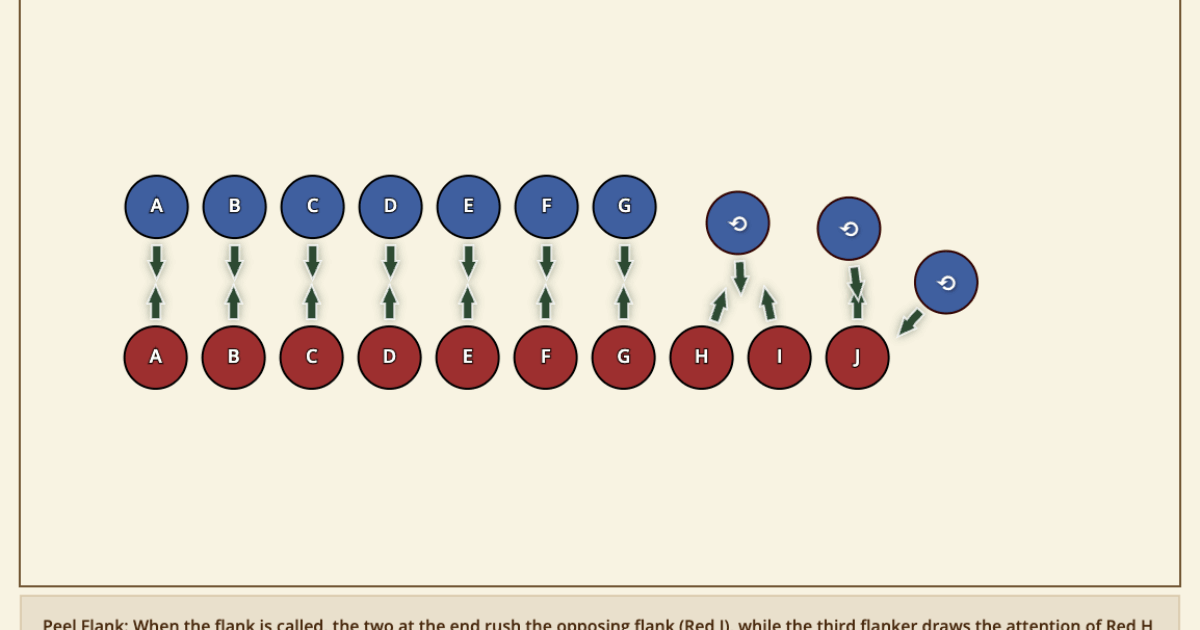The Flanking maneuver could be considered somewhat similar to the 45 maneuver used in two on one tactics. Though the flanking maneuver is focused on a line fight. You can use it to draw off one or two fighters to be able to break their flank, and crush them from the side. If the flank doesn’t move to address their flank, that person is fighting in a very similar position to the 45 maneuver in the two on one tactics, except they can’t just run and leave their line.
Points of safety
It is always important to do maneuvers safely. Make sure there is enough room on the battlefield for it. Make sure if you do crush the line and go for a zip (covered later), be in the 180, and be quick, but controlled. You are out of sight for the most part, take advantage of the opportunity, but watch hard shots.
- Be Aware of Your Surroundings: As you are pushing people against their own lines, be aware to call out any safety hazards or concerns.
- Prepare for Zips: After a flank, a common tactic is a zip where people attack along the lines close to the 180. You may receive shots to the side of your helmet. You may give or receive hard shots, so gauge your attacks accordingly.
- Watch 180s: Anytime you maneuver in the melee field, your and your opponent’s 180 changes rapidly. Be mindful of when you initiate an attack.
General Points
The point of this maneuver is to break the opponents line, just like any other maneuver. If you have a couple really strong fencers on the flank, and your opponent has one: if you can pull their good flank off the line, your second person in can break that side and crush the line, then come back and help. Also if you can get the line to bend, the person furthest out on the bend is the most vulnerable person. They have lost quite a bit of support from the person to their sides.
There are different ways of doing this, but it all comes down to defeating the strong opponents on the end of the line, so that they can crush the rest of the line.
- Break a Line: By applying pressure to the end of your opponent’s line, you can cause their line to bend back in on itself and present a weak point. Attacking that weak point can break their line into two smaller segments which are easier to overwhelm.
- Linesman Version: Use your flank (the person standing at one end of the line) to circle around the opposing line. As the line stretches, the person next to the flank should attack and punch through the weak point in the opposing line.
- Cavalry Version: Position a cavalry unit in the second or third position next to the flank. When the maneuver is called, they separate from the line and circle around the opposing line. The flank and remaining linesman attack the weak points, and the cavalry unit creates havoc from behind or eliminates the team’s commander.
- Defending Against a Flanking Maneuver: You have several options to defend against a flanking maneuver and stop it in its tracks.
- Extend your line: As they attempt to wrap around, extend your line so they never get behind or bend your line.
- Reinforce your flank: Send a fighter to support and defend your flank person.
- Counter Flank: As they flank from one side, initiate your own flanking maneuver from the other end of the line.
- Shadow Their Flanker: As the opposing team sends someone to flank the line, send someone to shadow them and take them out of the fight, neutralizing their efforts
- Scotland Rules: Forget the line and send everyone out as a cavalry unit to fight on their own.
Training Ideas
- Set Up a Line to Flank: Establish who is responsible for each aspect of whichever flank you’re doing and where they should be going.
- Defend against a Flank: Set up a line and practice defending it against a flanking maneuver.
- Perform a Flank: Repeatedly attack a line with flanking maneuvers.
- Perform a Zip: Go down the line in a waterfall doing the zips, and joining the end of the line when done with the zip.
Assessment
- Flanking Safety: Fencers should be aware of obstacles and make decisions if it is safe to do the maneuver. Fencers should also be safe and keeping in 180 for the Zip.
- Flanking Basics: How to effective utilize the tactic. Be able to understand when you should and shouldn’t do the flanking maneuver.
- Flanking Training: Get in line fights and try doing the flank. Learn what works, and what doesn’t work. Like anything in melees, the smallest of details like a single side weapon can change how it works.

